Abstract
The vascular complications of scleroderma have previously been attributed to the progressive obliteration of small vessels. Our study was carried out to determine whether abnormalities of blood viscosity occur in this disease, thereby contributing to the ischaemic process. Blood viscosity was measured in 20 patients using a rotational viscometer. At a high rate of shear, blood hyperviscosity was found in 35% of the patients and at a low rate of shear, in 70%. In addition there was a significant increase in the plasma viscosity which implicates changes in plasma proteins (fibrinogen, immunoglobulins) as causing the hyperviscosity. Measurement of the hand blood flow by venous occlusion plethysmography showed reduced flow at 32°, 27°, and 20°C. A unique finding was a delayed recovery of the blood flow after cooling. These observations suggest that the increased resistance to blood flow in skin affected by scleroderma may be caused by an interaction between the occlusive vascular lesion and blood hyperviscosity. In addition, blood flow patterns and hyperviscosity could help distinguish scleroderma from primary Raynaud's disease.
Full text
PDF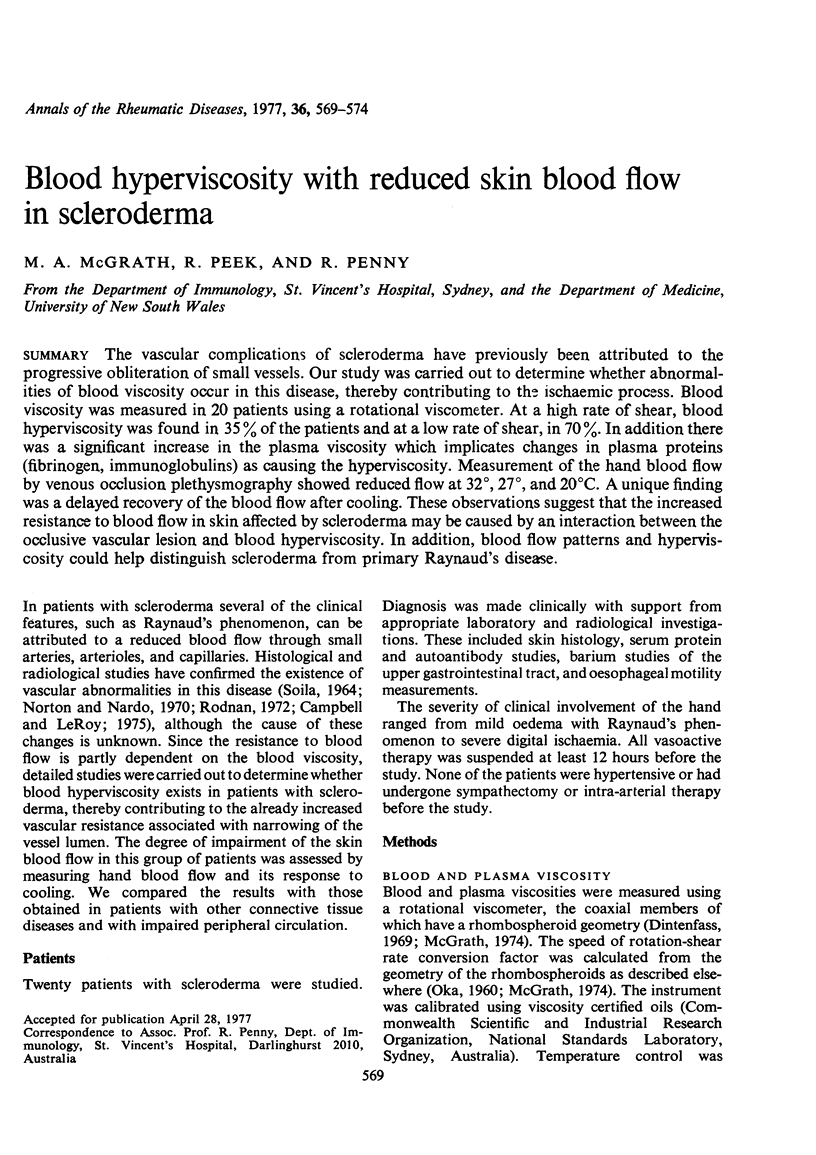
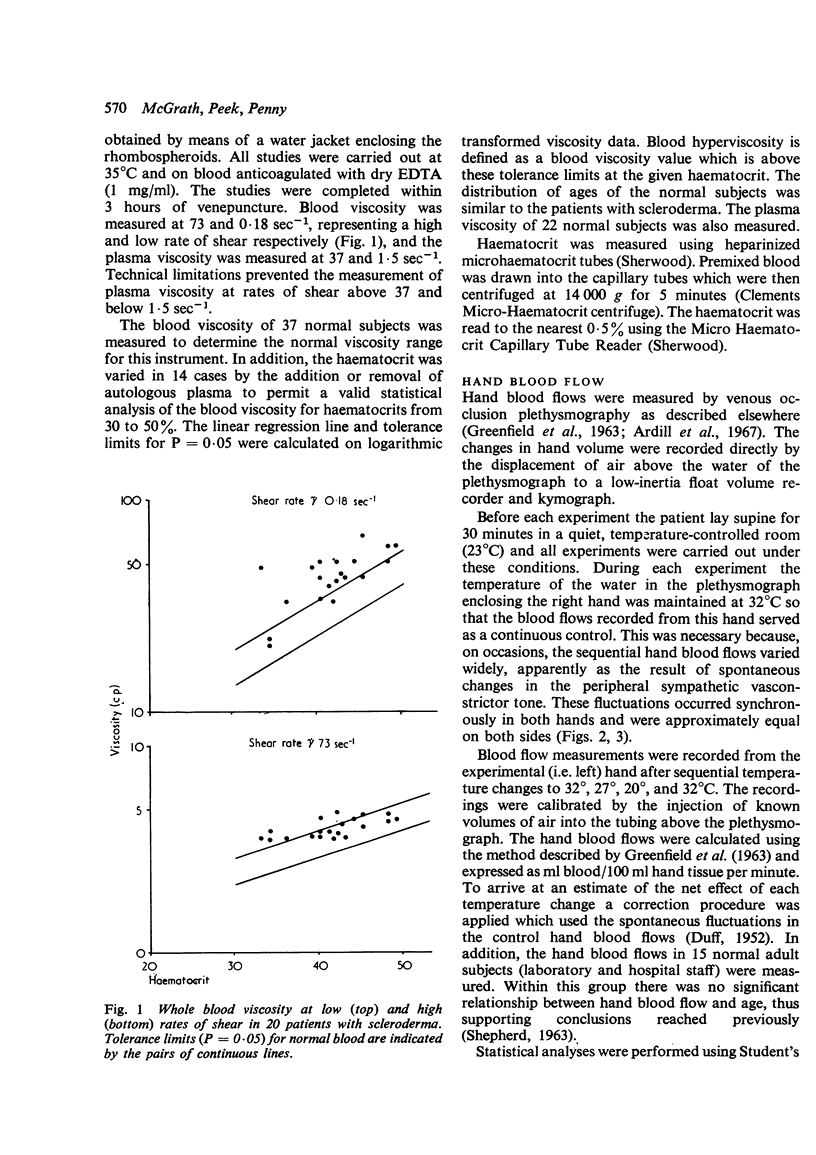
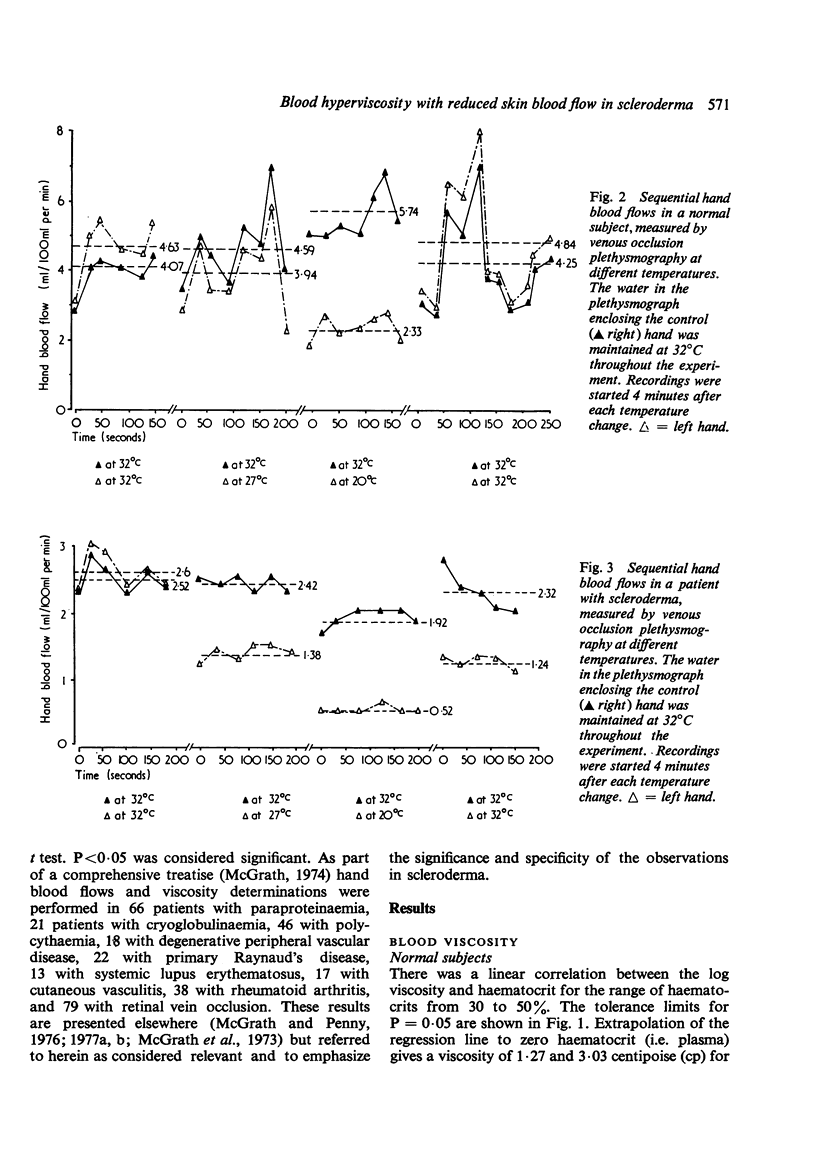
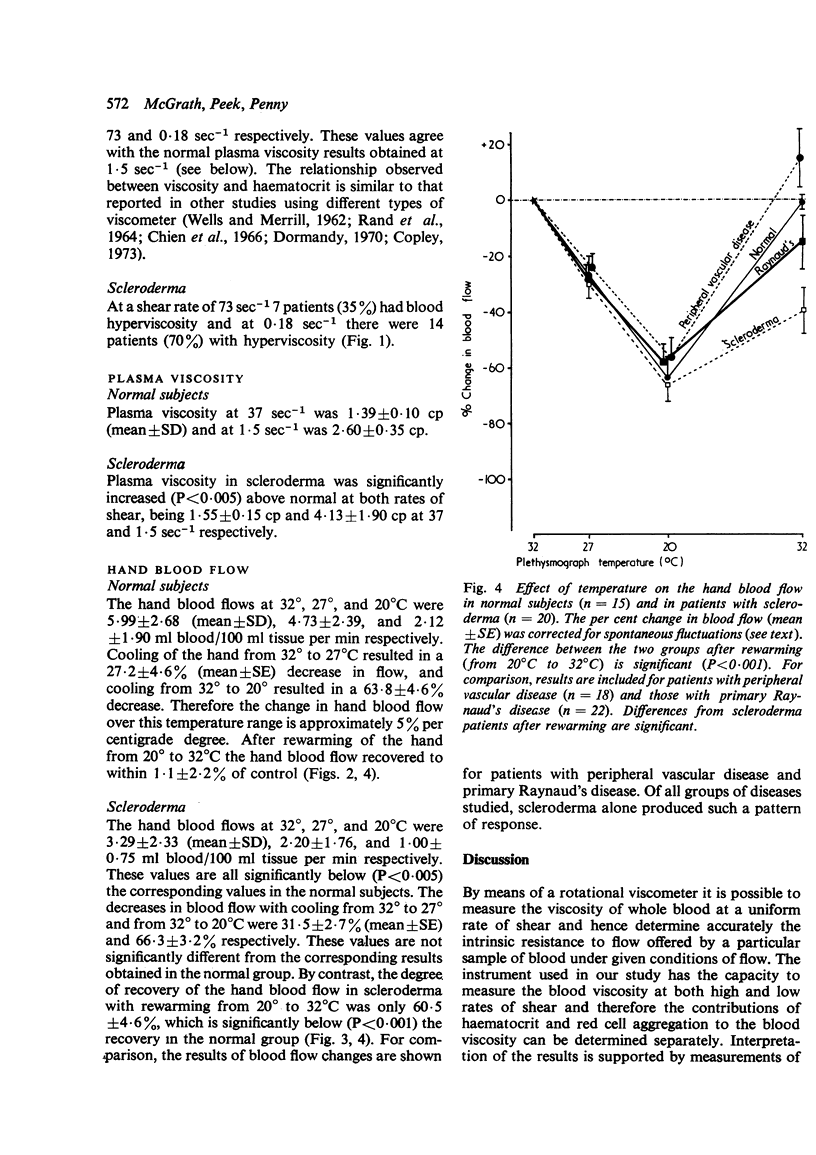
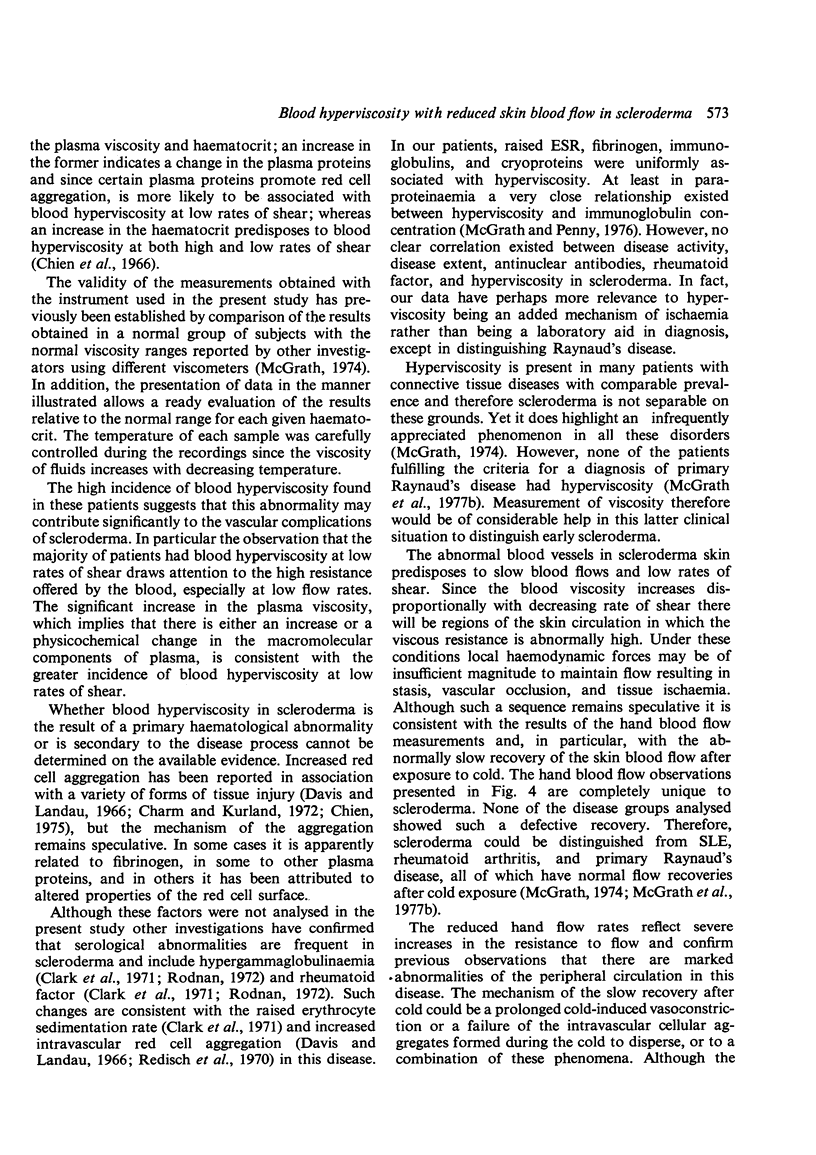

Selected References
These references are in PubMed. This may not be the complete list of references from this article.
- Ardill B. L., Bhatnagar V. M., Fentem P. H., Greenfield A. D. Clinical use of venous occlusion plethysmography. Scand J Clin Lab Invest Suppl. 1967;99:95–100. [PubMed] [Google Scholar]
- Campbell P. M., LeRoy E. C. Pathogenesis of systemic sclerosis: a vascular hypothesis. Semin Arthritis Rheum. 1975 May;4(4):351–368. doi: 10.1016/0049-0172(75)90017-7. [DOI] [PubMed] [Google Scholar]
- Chien S., Usami S., Taylor H. M., Lundberg J. L., Gregersen M. I. Effects of hematocrit and plasma proteins on human blood rheology at low shear rates. J Appl Physiol. 1966 Jan;21(1):81–87. doi: 10.1152/jappl.1966.21.1.81. [DOI] [PubMed] [Google Scholar]
- Clark J. A., Winkelmann R. K., Ward L. E. Serologic alterations in scleroderma and sclerodermatomyositis. Mayo Clin Proc. 1971 Feb;46(2):104–107. [PubMed] [Google Scholar]
- Copley A. L. On biorheology. Biorheology. 1973 Jun;10(2):87–105. doi: 10.3233/bir-1973-10203. [DOI] [PubMed] [Google Scholar]
- DUFF R. S. Effect of sympathectomy on the response to adrenaline of the blood vessels of the skin in man. J Physiol. 1952 Aug;117(4):415–430. doi: 10.1113/jphysiol.1952.sp004758. [DOI] [PMC free article] [PubMed] [Google Scholar]
- Dintenfass L. A coaxial rhombo-spheroid viscometer: a further development of the cone-in-cone viscometer. Biorheology. 1969 Apr;6(1):33–36. doi: 10.3233/bir-1969-6104. [DOI] [PubMed] [Google Scholar]
- Dormandy J. A. Clinical significance of blood viscosity. Ann R Coll Surg Engl. 1970 Oct;47(4):211–228. [PMC free article] [PubMed] [Google Scholar]
- GREENFIELD A. D., WHITNEY R. J., MOWBRAY J. F. Methods for the investigation of peripheral blood flow. Br Med Bull. 1963 May;19:101–109. doi: 10.1093/oxfordjournals.bmb.a070026. [DOI] [PubMed] [Google Scholar]
- McGarth M. A., Tracy G. D., Lord R. S., Penny R. Peripheral ischaemia caused by blood hyperviscosity. Aust N Z J Surg. 1973 Sep;43(2):109–113. doi: 10.1111/j.1445-2197.1973.tb07320.x. [DOI] [PubMed] [Google Scholar]
- McGrath M. A., Penny R. Paraproteinemia: blood hyperviscosity and clinical manifestations. J Clin Invest. 1976 Nov;58(5):1155–1162. doi: 10.1172/JCI108568. [DOI] [PMC free article] [PubMed] [Google Scholar]
- Norton W. L., Nardo J. M. Vascular disease in progressive systemic sclerosis (scleroderma). Ann Intern Med. 1970 Aug;73(2):317–324. doi: 10.7326/0003-4819-73-2-317. [DOI] [PubMed] [Google Scholar]
- RAND P. W., LACOMBE E., HUNT H. E., AUSTIN W. H. VISCOSITY OF NORMAL HUMAN BLOOD UNDER NORMOTHERMIC AND HYPOTHERMIC CONDITIONS. J Appl Physiol. 1964 Jan;19:117–122. doi: 10.1152/jappl.1964.19.1.117. [DOI] [PubMed] [Google Scholar]
- Redisch W., Messina E. J., Hughes G., McEwen C. Capillaroscopic observations in rheumatic diseases. Ann Rheum Dis. 1970 May;29(3):244–253. doi: 10.1136/ard.29.3.244. [DOI] [PMC free article] [PubMed] [Google Scholar]
- SOILA P. SOME FEATURES OF ANGIOGRAPHIC FINDINGS IN RHEUMATOID ARTHRITIS AND SCLERODERMA. Acta Rheumatol Scand. 1964;10:189–192. doi: 10.3109/rhe1.1964.10.issue-1-4.20. [DOI] [PubMed] [Google Scholar]
- WELLS R. E., Jr, MERRILL E. W. Influence of flow properties of blood upon viscosity-hematocrit relationships. J Clin Invest. 1962 Aug;41:1591–1598. doi: 10.1172/JCI104617. [DOI] [PMC free article] [PubMed] [Google Scholar]


